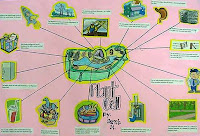Cell Structure & Function
Science 9 IPP
Science of Cells
You can’t see them, but they’re everywhere!
All things that live are made from cells. You can’t see them, but every part of your body, including everything inside your body, is made from cells. Cells eat, grow, and make more of themselves (scientists call this replication).There are millions of different types of cells. Dog cells are different from fish cells. Bird cells are different from your cells. And inside your body, there are many different cells, each one doing a different job to keep your body going.
Did You Know That...
The cell is the basic unit of life?There are between 50 and 75 trillion cells in your body?
Human red blood cells live for around 120 days, but stomach cells only last 2 days?
The biggest single cell you might ever see is the ostrich egg?
Watch the following videos as Bill Nye explains cells:
Plant Cell
TASK
Learn about the plant cell.
Parts of the Cell
The parts of the cell can be compared to your house!
| nucleus | Remote Control - brain of the cell |
| vacuole | Cupboard - stores wastes, water, food |
| chromosomes | Blue Print - genetic material found in the nucleus |
| mitochondria | Furnace - where energy is produced |
| ribosomes | Kitchen - proteins are made |
| endoplasmic reticulum | Hallway - transport system in the cell |
| golgi apparatus | ZipLock Baggies - packages up protein |
| lysosome | Recycling - breaks down large molecules |
| chloroplast | Green - where photosynthesis occurs (plants only) |
| cell membrane | Door - controls what moves in and out of the cell |
| cell wall | Walls - protects and supports plant cells |
Build a Cell
You can use any materials you prefer - Styrofoam, poster, even cake! Below is an idea using Jello...
Materials
Jello
Water
1 Large Freezer zip lock bag
Various candy/fruit to represent cell structures
- Make Jello according to package, except use less water then instructions recommend to ensure your cytoplasm will be sturdy enough to hold all of the organelles
- Pour Jello into the plastic bag. The bag acts as the cell wall or membrane.
- Place Jello in refrigerator for about 45 minutes, until it is almost set but not quite.
- Meanwhile... choose which items you will use to represent the various organelles.
- When Jello is mostly set, push the 'organelles' into place.
- Allow the Jell-O to set for about 20 more minutes.
2. Label a cell diagram indicating what you used to represent the organelles (paper or digital).
TASK 1
Create a presentation about the parts of the cell (paper, Book Creator, Tellagami, claymation...). Include the function of each:
Cell Wall
Cell Membrane
Nucleus
Chloroplast
Mitochondria
Endoplasmic Reticulum
Golgi Body
Vacuole
Cytoplasm
TASK 2
Indicate whether they are found in a plant cell or animal cell or both.
TASK 3
Answer the following:
Create a presentation about the parts of the cell (paper, Book Creator, Tellagami, claymation...). Include the function of each:
Cell Wall
Cell Membrane
Nucleus
Chloroplast
Mitochondria
Endoplasmic Reticulum
Golgi Body
Vacuole
Cytoplasm
TASK 2
Indicate whether they are found in a plant cell or animal cell or both.
TASK 3
Answer the following:
- What cell parts do Animal cells have that Plant cells do not have?
- What cell parts do Plant cells have that Animal cells do not have?
- Why do Plant cells have cell walls and Animal cells do not?
- Why do think Plant cells have bigger vacuoles than Animal cells?
Check Your Understanding
Solve the mystery of the mixed up cells!
Label the animal cell diagram, print and place in your binder
Label the plant cell diagram, print, and place in your binder.
Label the animal cell diagram, print and place in your binder
Label the plant cell diagram, print, and place in your binder.
Subscribe to:
Comments (Atom)


